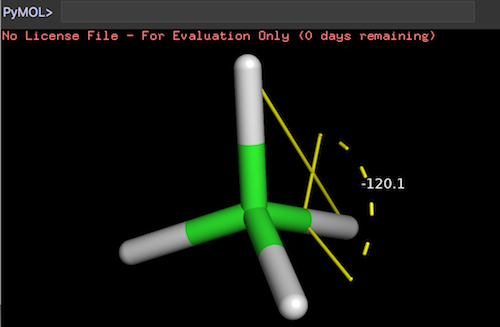Molecule Tutorials - Herong's Tutorial Examples - v1.26, by Herong Yang
Dihedral Angle Formed by 3 Atoms in PyMol
This section provides a tutorial on how to measure the dihedral angle formed by 4 picked atoms using the 'get_dihedral/dihedral' command in PyMol.
PyMol 4 picked atoms identified as pk1, pk2, pk3 and pk4 selections can also be used to measure the dihedral angle formed by 4 atoms.
"get_dihedral" prints the dihedral angle formed by 4 picked atoms in the message output console:
# print dihedral angle formed by 4 atoms: pk1, pk2, pk3, pk4 get_dihedral # print dihedral angle formed by 4 atoms: pk2, pk3, pk4, pk1 get_dihedral pk2, pk3, pk4, pk1
"dihedral" creates a new visualization selection to show the dihedral angle formed by 4 picked atoms:
# create dihedral angle (named as dih1) formed by pk1, pk2, pk3, pk4 dihedral dih1 # create dihedral angle (named as ang2) formed by pk2, pk3, pk4, pk1 dihedral dih2, pk2, pk3, pk4, pk1

Table of Contents
Molecule Names and Identifications
Nucleobase, Nucleoside, Nucleotide, DNA and RNA
"get_extent" - Picked Atom Location
"label" - Generate Labels on Atoms
Distance between Atoms in PyMol
Angle Formed by 3 Atoms in PyMol
►Dihedral Angle Formed by 3 Atoms in PyMol
Use Selection Expressions in PyMol
"get_area" - Surface Areas of Atoms
Surface Area of Entire Molecule
"get_position" - Viewing Center
ChEMBL Database - European Molecular Biology Laboratory
PubChem Database - National Library of Medicine
INSDC (International Nucleotide Sequence Database Collaboration)
HGNC (HUGO Gene Nomenclature Committee)